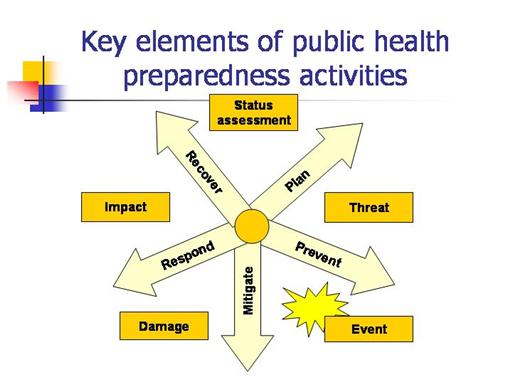| front |1 |2 |3 |4 |5 |6 |7 |8 |9 |10 |11 |12 |13 |14 |15 |16 |17 |18 |19 |20 |review |
 |
There are five essential phases
in the management of disasters: – planning, prevention, preparation
(mitigation), respond and recovery. They are closely linked. Focus of
action of each of these phases is placed between different periods in
relation of disaster events:
•- Pre-event phase – planning and prevention
•- Event - early detection and incident command
•- Post even phase - mitigate of
consequences, early response and recovery
Planning:
on the basis of demographics, mortality and morbidity data, information
about health system and epidemiological investigation and
needs assessment analysis, all hazard and
specific hazard plans should be developed.
Prevention: this
describes those activities that can be implemented following the risk
assessment to stop the designated major disaster/incident from occurring
(or minimising its likelihood) – these are examples of hazard
reduction programmes.
Risk reduction methods are
based on the principles of acceptance, avoidance, and mitigation. Some
examples of hazard reduction plans are remediation of contaminated land
before building on or building barriers to reduce a flooding risk.
Mitigation: this
describes those activities, whose implementation as soon as there is
advance warning of an imminent threat will minimise the impact of the
incident. Activities include both forecasting and implementing the
precautionary measures.
It involves both organisations
and individuals who are involved in the response, recovery and
post-incident audit phases.
Mitigation is based on
vulnerability reduction programmes. Vulnerability reduction
describes those activities whose implementation is designed to minimise
the consequences of a hazard event. This is achieved by lowering the
vulnerability to hazards and /or reducing the number of elements at
risk. Some examples of vulnerability reduction plans are
designing earthquake proof buildings or heat wave watch scheme.
Response: this describes
those activities whose implementation in the immediate aftermath of a
major disaster/ incident will provide health and social care (to
casualties/ those affected by the incident), and will rehabilitate or
reconstruct the physical structures of the community. Essential elements
of the response include equitable access to adequate safe water,
hygienic sanitation, and food and shelter, and protection of affected
populations from ill-health and violation. Responses should give
priority to the most vulnerable people: women (especially when
pregnant), young children, older people and persons who are disabled or
chronically ill.
It includes how the
emergency preparedness and response plan is activated (including
Alert and Standby). There are many different emergency plans, some of
them being:
•-generic (all hazards) or specific;
•-single agency or multi-agency;
•-local, regional or national;
•-business continuity plans.
Response activities include
many different actions as follows:
•-Development of specific incident algorithm
•-Command and control
•-Safety (self, scene and survivors)
•-Communication
•-Scene assessment
•-Triage
•-Treatment
•-Transport
|